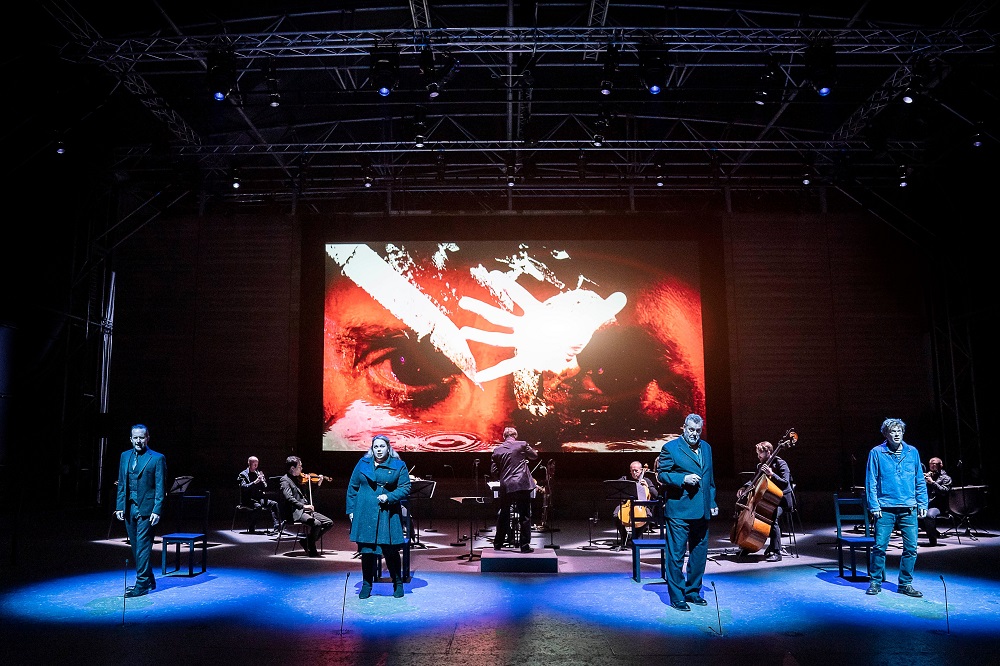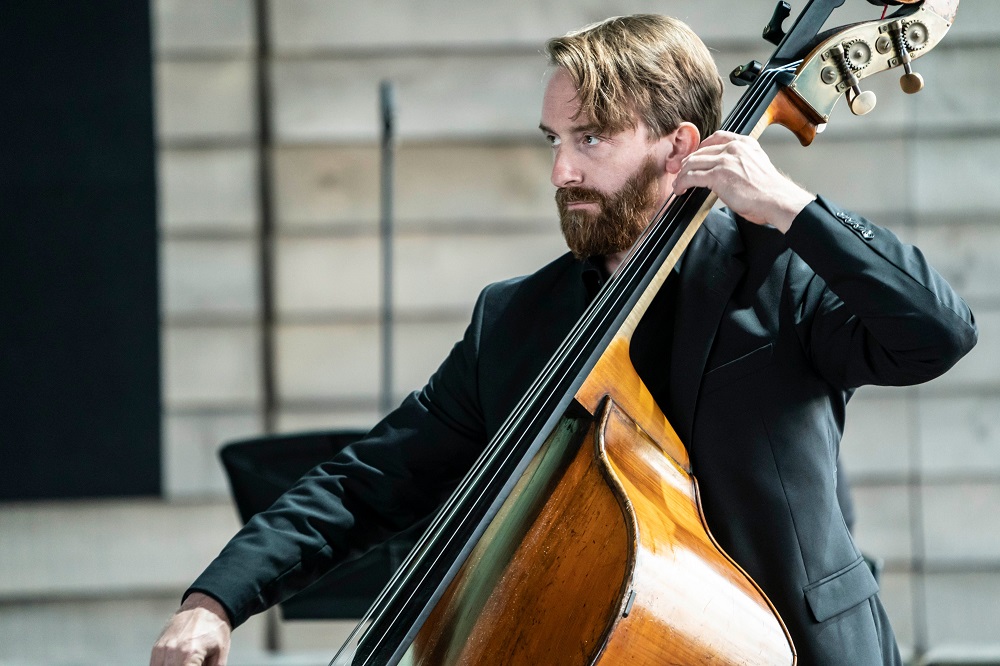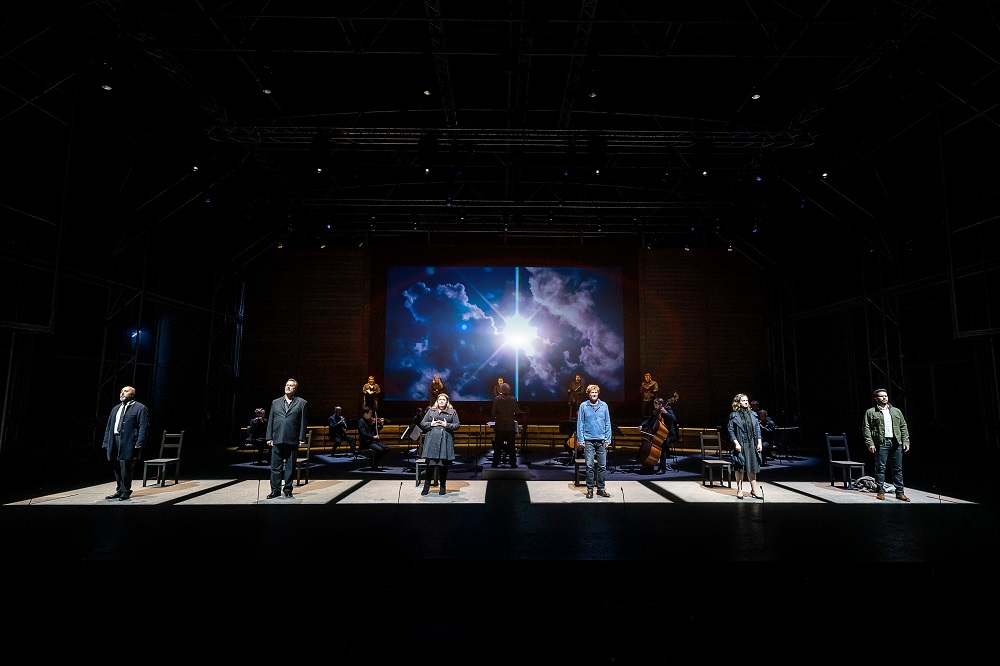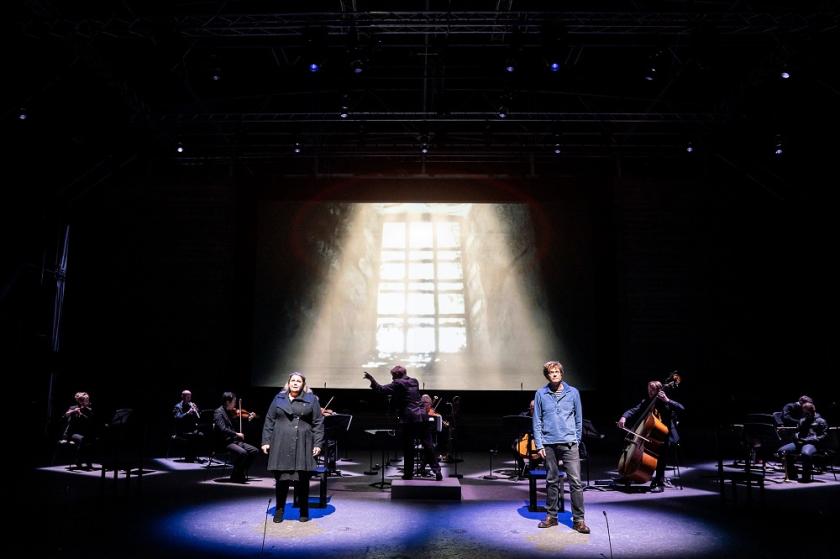It may be only six and a half months since many of us saw a production of Beethoven’s Fidelio in the opera house, but that was another world, and this post-lockdown admittance to Garsington Opera’s spacious, award-winning pavilion with its impressive acoustic was always going to be something extraordinary. It turned out to be all the more so given the revelations of what you can hear in Beethoven’s score as arranged by Francis Griffin for an ensemble of 13 Philharmonia players – as conductor Douglas Boyd pointed out, not better than the original, but startlingly different – and the descent to the darkness of the cell in which the disguised Leonore finds her political-prisoner husband on the brink of death and imminent execution.
At first there was something of a cognitive dissonance between the views out to the trees and garden of the Wormsley Estate and the supposed confines of a prison yard. But the entire presentation, devised by Renaissance man Peter Mumford when Boyd presented Fidelio in Paris, focused the attention visually just as the ensemble on stage did aurally right from the start. Mumford‘s lighting, kept the main characters within their individual squares of light - replaced by blue pools in the first scene of Act Two - and the video projections in assocation with William Reynolds were very artistically filmed black and white prison scenes inside and out slowly transitioning into colour.  Pairs of eyes haunted us – four pairs in the blissful canon-quartet, later 15 as a pre-filmed Garsington male chorus delivered the Prisoners’ Chorus (there were also five choristers, two men and three women, to give the final liberation a special intimacy). At the moment when prison governor PIzarro thinks to achieve his vengeance on Florestan, his eyes have it - but not for long after Leonore's outstretched hand meets his dagger (pictured above). Without an interval, the journey from light to dark was unique – night had fallen outside by the time we reached the dungeon, and I’ve never felt so palpably in any production the subterranean chill (even the falling temperatures of the breezes from outside suggested the dankness). .
Pairs of eyes haunted us – four pairs in the blissful canon-quartet, later 15 as a pre-filmed Garsington male chorus delivered the Prisoners’ Chorus (there were also five choristers, two men and three women, to give the final liberation a special intimacy). At the moment when prison governor PIzarro thinks to achieve his vengeance on Florestan, his eyes have it - but not for long after Leonore's outstretched hand meets his dagger (pictured above). Without an interval, the journey from light to dark was unique – night had fallen outside by the time we reached the dungeon, and I’ve never felt so palpably in any production the subterranean chill (even the falling temperatures of the breezes from outside suggested the dankness). .
And these were merely the outer layers, though they went deep. Inward depth of expression came immediately from Galina Averina‘s Marzelline, less of a light soprano than usual – how artistically she echo-faded the top B flat of Katherine Broderick’s Leonore in that intensely moving final quintet with chorus – in repartee with Trystan Llŷr Griffiths' Jaquino. Stephen Richardson’s Rocco commanded his limited space with deft dramatic characterisation; if Andrew Foster Williams's prison governor Pizarro hardly offered as much authority, it was a more convincing shot than Simon Neal's in this year’s Royal Opera production.
 Lisa Davidsen’s Royal Opera Leonore was always going to be a hard act to follow, but Broderick (pictured right) has her own personality and dramatic-soprano sound, a little in line with the great Rita Hunter, the breadth of tone reined in to negotiate the lighter passages and runs (though her top notes were all secure, she wisely and stylishly took the lower option, up to an A rather than a B, at the end of the big aria, the voice thrillingly matched with the two superlative horns (Diego Incertis Sánchez and Kira Doherty).You might not expect to find the once lighter lyric tenor of Toby Spence tackling the killer role of Florestan; the end of his complementary set piece at the beginning of Act Two sounded as strenuous as most, but he did it, and the general under-pressure quality was backed up by dramatic conviction.
Lisa Davidsen’s Royal Opera Leonore was always going to be a hard act to follow, but Broderick (pictured right) has her own personality and dramatic-soprano sound, a little in line with the great Rita Hunter, the breadth of tone reined in to negotiate the lighter passages and runs (though her top notes were all secure, she wisely and stylishly took the lower option, up to an A rather than a B, at the end of the big aria, the voice thrillingly matched with the two superlative horns (Diego Incertis Sánchez and Kira Doherty).You might not expect to find the once lighter lyric tenor of Toby Spence tackling the killer role of Florestan; the end of his complementary set piece at the beginning of Act Two sounded as strenuous as most, but he did it, and the general under-pressure quality was backed up by dramatic conviction.
Given a chamber group as a kind of Greek chorus, the players also became dramatic participants, on a level with the singers. The acoustics loved the characterful woodwind solos, Timothy Rundle‘s oboe above all, which Beethoven asks to go insanely high for Florestan’s fevered vision, and which brought instant tears to the eyes in the timeless rapture just before the final hymn to Leonore. Astonishing, too, how much focus a string quintet could bring, and how Tim Gibbs‘s double bass (pictured below) could freeze the blood. One special focus was in how Beethoven slowly sheds the Mozartian mantle to pursue his own heart of darkness: it hit us first when Rocco sings in the duet with Pizarro of Florestan as “hardly alive, hovering like a shadow” and it threaded its way through the early numbers of Act 2 without impedance from any dialogue - the action is described on the screen – even in the melodrama at the start of No. 12, sounding more radical than ever.  That only made the liberation all the fresher. I don’t think I’ve ever heard the moment in the Act Two Quartet where Leonore interposes herself between Pizarro and Florestan singing “Töt erst sein Weib!” (“first kill his wife”) more thrillingly delivered than it was by Broderick, and the trumpet call of imminent liberation delivered another spine-tingling moment in the brilliant hands of Jason Evans. All this was the more remarkable when one remembers - I'd rather not - how director Tobias Kratzer botched the tension of the entire scene in the disastrous second act of the Royal Opera's Fidelio. For those of us who find a large-scale parade ground finale typical of Beethoven hammering in one nail too many, this ending delivered something much more convincing – a personal emancipation, the rhythms kept crisp and elevated by Boyd. You could only go out into the torch and brazier lit grounds the lighter after that.
That only made the liberation all the fresher. I don’t think I’ve ever heard the moment in the Act Two Quartet where Leonore interposes herself between Pizarro and Florestan singing “Töt erst sein Weib!” (“first kill his wife”) more thrillingly delivered than it was by Broderick, and the trumpet call of imminent liberation delivered another spine-tingling moment in the brilliant hands of Jason Evans. All this was the more remarkable when one remembers - I'd rather not - how director Tobias Kratzer botched the tension of the entire scene in the disastrous second act of the Royal Opera's Fidelio. For those of us who find a large-scale parade ground finale typical of Beethoven hammering in one nail too many, this ending delivered something much more convincing – a personal emancipation, the rhythms kept crisp and elevated by Boyd. You could only go out into the torch and brazier lit grounds the lighter after that.  All this was done at the highest level, circumstances notwithstanding. And I should give a special shout-out to the amazing work of Garsington’s education and outreach programmes during lockdown, making an opera related to Fidelio’s theme to the imprisonment within themselves sometimes felt by stroke sufferers; a real-life Leonore spoke movingly of how far her Florestan felt from her at first in a four-minute film shown at the beginning of the evening. May a company which has in the past few years come up to Glyndebourne standards, and sometimes excelled it in productions – I think especially of Death in Venice, Idomeneo with Spence and The Cunning Little Vixen – return next summer all the stronger.
All this was done at the highest level, circumstances notwithstanding. And I should give a special shout-out to the amazing work of Garsington’s education and outreach programmes during lockdown, making an opera related to Fidelio’s theme to the imprisonment within themselves sometimes felt by stroke sufferers; a real-life Leonore spoke movingly of how far her Florestan felt from her at first in a four-minute film shown at the beginning of the evening. May a company which has in the past few years come up to Glyndebourne standards, and sometimes excelled it in productions – I think especially of Death in Venice, Idomeneo with Spence and The Cunning Little Vixen – return next summer all the stronger.















Add comment